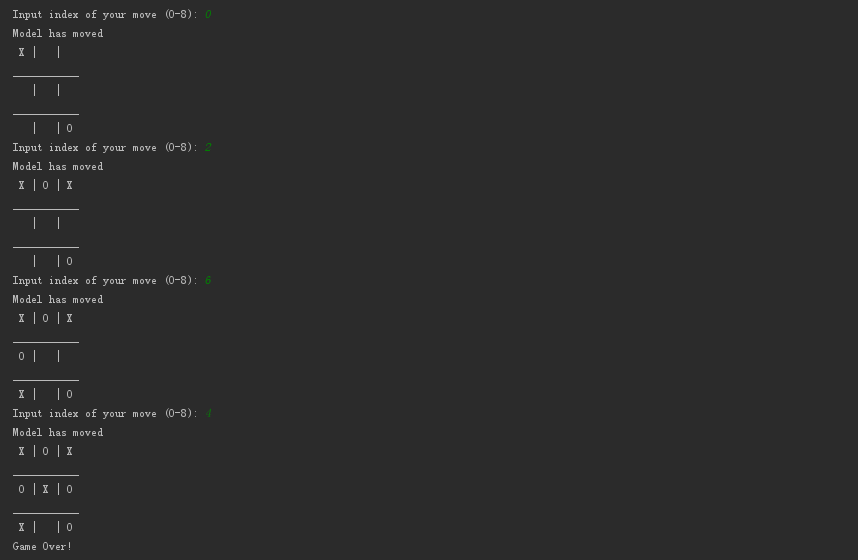import tensorflow as tf
import matplotlib.pyplot as plt
import csv
import random
import numpy as np
#井字棋的打印函数
def print_board(board):
symbols = ['O',' ','X','N']
board_plus1 = [int(x) + 1 for x in board]
print(' ' + symbols[board_plus1[0]] + ' | ' + symbols[board_plus1[1]] + ' | ' + symbols[board_plus1[2]])
print('___________')
print(' ' + symbols[board_plus1[3]] + ' | ' + symbols[board_plus1[4]] + ' | ' + symbols[board_plus1[5]])
print('___________')
print(' ' + symbols[board_plus1[6]] + ' | ' + symbols[board_plus1[7]] + ' | ' + symbols[board_plus1[8]])
#变化之后的棋盘 以及最佳落子点 通过旋转棋盘 得到对应的图形记录
def get_symmetry(board, response, transformation):
if transformation == 'rotate180':
new_response = 8 - response
return(board[::-1], new_response)
elif transformation == 'rotate90':
new_response = [6, 3, 0, 7, 4, 1, 8, 5, 2].index(response)
tuple_board = list(zip(*[board[6:9], board[3:6], board[0:3]]))
return([value for item in tuple_board for value in item], new_response)
elif transformation == 'rotate270':
new_response = [2, 5, 8, 1, 4, 7, 0, 3, 6].index(response)
tuple_board = list(zip(*[board[0:3], board[3:6],board[6:9]]))[::-1]
return([value for item in tuple_board for value in item], new_response)
elif transformation == 'flip_v':
new_response = [6, 7, 8, 3, 4, 5, 0, 1, 2].index(response)
return(board[6:9] + board[3:6] + board[0:3], new_response)
elif transformation == 'flip_h':
# flip_h = rotate180, then flip_v
new_response = [2, 1, 0, 5, 4, 3, 8, 7, 6].index(response)
new_board = board[::-1]
return(new_board[6:9] + new_board[3:6] + new_board[0:3],new_response)
else:
raise ValueError('Method not implmented.')
#加载文件中的棋盘和最佳落子点数据,并保存成元组
moves = []
def get_moves_from_csv(csv_file):
with open(csv_file, 'rt') as csvfile:
reader = csv.reader(csvfile, delimiter=',')
for row in reader:
moves.append(([int(x) for x in row[0:9]], int(row[9])))
return (moves)
#写入文件 获取一种最优解 得到变形后的其余几种 都存入数据表中
def wrrite_moves_from_csv(csv_file,data):
moves=get_moves_from_csv(csv_file)
with open(csv_file,'a+',newline='') as csvfile:
writer = csv.writer(csvfile,lineterminator='\n')
allmoves=get_other_move(data)
allmoves=[ x for x in allmoves if (x[0:-1],x[-1]) not in moves]
writer.writerows(allmoves)
def get_other_move(data):
possible_transforms = ['rotate90', 'rotate180', 'rotate270', 'flip_v', 'flip_h']
otherMoves=[]
for transform in possible_transforms:
(board, response) = get_symmetry(data[0:-1], data[-1], transform)
new=board+[response]
new=list(map(lambda x:int(x),new))
otherMoves.append(new)
return otherMoves
#返回一个随机变换棋盘和落子点
def get_rand_move(moves):
# This function performs random transformations on a board.
#(board, response) = random.choice(moves)
possible_transforms = ['rotate90', 'rotate180', 'rotate270', 'flip_v', 'flip_h']
fourBoards=[]
#random_transform = random.choice(possible_transforms)
for board,response in moves:
for transform in possible_transforms:
(board, response) = get_symmetry(board, response, transform)
fourBoards.append((board, response))
return fourBoards
sess = tf.Session()
moves = get_moves_from_csv('base_tic_tac_toe_moves.csv')
batch_size = 100
train_length = 100
train_set = []
train_set=moves*train_length
#设置测试集 训练集 测试集最优为6
test_board = [0, 0, -1, 1, -1, -1, 0, 0, 1]
train_set = [x for x in train_set if x[0] != test_board]
#创建init_weights()函数和model()函数,分别实现初始化模型变量和模型操作
def init_weights(shape):
return(tf.Variable(tf.random_normal(shape)))
def model(X, A1, A2, bias1, bias2):
layer1 = tf.nn.sigmoid(tf.add(tf.matmul(X, A1), bias1))
layer2 = tf.add(tf.matmul(layer1, A2), bias2)
return(layer2)
#声明占位符、变量和模型
X = tf.placeholder(dtype=tf.float32, shape=[None, 9])
Y = tf.placeholder(dtype=tf.int32, shape=[None])
A1 = init_weights([9, 81])
bias1 = init_weights([81])
A2 = init_weights([81, 9])
bias2 = init_weights([9])
model_output = model(X, A1, A2, bias1, bias2)
#声明算法模型的损失函数,该函数是最后输出的逻辑变换的平均softmax值 #由之前的概率值转化为对应的预测label的索引
loss = tf.reduce_mean(tf.nn.sparse_softmax_cross_entropy_with_logits( logits=model_output,labels=Y))
train_step = tf.train.GradientDescentOptimizer(0.025).minimize(loss)
prediction = tf.argmax(model_output, 1)
# Initialize variables
init = tf.initialize_all_variables()
sess.run(init)
loss_vec = []
for i in range(10000):
# Select random indices for batch
rand_indices = np.random.choice(range(len(train_set)), batch_size, replace=False)
# Get batch
batch_data = [train_set[i] for i in rand_indices]
x_input = [x[0] for x in batch_data]
y_target = np.array([y[1] for y in batch_data])
# Run training step
sess.run(train_step, feed_dict={X: x_input, Y: y_target})
# Get training loss
temp_loss = sess.run(loss, feed_dict={X: x_input, Y: y_target})
loss_vec.append(temp_loss)
if i%1000==0:
print('iteration ' + str(i) + ' Loss: ' + str(temp_loss))
test_boards = [test_board]
feed_dict = {X: test_boards}
logits = sess.run(model_output, feed_dict=feed_dict)
#print(logits)
predictions = sess.run(prediction, feed_dict=feed_dict)
print_board(test_board)
print(predictions)
#人机对局监测
#检测函数 游戏是否结束
def check(board):
wins = [[0, 1, 2], [3, 4, 5], [6, 7, 8], [0, 3, 6], [1, 4, 7], [2, 5, 8], [0, 4, 8], [2, 4, 6]]
for i in range(len(wins)):
if board[wins[i][0]] == board[wins[i][1]] == board[wins[i][2]] == 1.:
return (1)
elif board[wins[i][0]] == board[wins[i][1]] == board[wins[i][2]] == -1.:
return (1)
return (0)
#初始化棋盘
game_tracker = [0, 0, 0, 0, 0, 0, 0, 0, 0]
win_logical = False
num_moves = 0
#实时面板登记
tempBoard=[]
while not win_logical:
player_index = input('Input index of your move (0-8): ')
# 记录用户操作
tempBoard.append(game_tracker + [int(player_index)])
#步数
num_moves += 1
# Add player move to game
try:
game_tracker[int(player_index)] = 1.
except:
print('不合法的输入')
continue
# Get model's move by first getting all the logits for each index
[potential_moves] = sess.run(model_output, feed_dict={X:[game_tracker]})
# Now find allowed moves (where game tracker values = 0.0)
allowed_moves = [ix for ix,x in enumerate(game_tracker) if x==0]
# Find best move by taking argmax of logits if they are in allowed moves
model_move = np.argmax([x if ix in allowed_moves else -999 for ix,x in enumerate(potential_moves)])
# Add model move to game
game_tracker[int(model_move)] = -1.
print('Model has moved')
print_board(game_tracker)
# Now check for win or too many moves
if check(game_tracker)==1 or num_moves>=5:
print('Game Over!')
if check(game_tracker)==1:
wrrite_moves_from_csv('base_tic_tac_toe_moves.csv', tempBoard[-2])
wrrite_moves_from_csv('base_tic_tac_toe_moves.csv',tempBoard[-1])
conKey = input('Input 1 to end this game ')
if conKey== "1":
win_logical = True
game_tracker = [0, 0, 0, 0, 0, 0, 0, 0, 0]
tempBoard = []
num_moves=0







 浙公网安备 33010602011771号
浙公网安备 33010602011771号